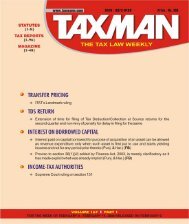CPT V24P7-Art1 (Content).pmd - Taxmann
CPT V24P7-Art1 (Content).pmd - Taxmann
CPT V24P7-Art1 (Content).pmd - Taxmann
You also want an ePaper? Increase the reach of your titles
YUMPU automatically turns print PDFs into web optimized ePapers that Google loves.
to agree with the assessee’s contention<br />
that the joint ownership of the property<br />
would not stand in the way of claiming<br />
exemption under section 54F”.<br />
The High Court distinguished: (a) the decision<br />
of the Delhi High Court in the case of Vipin<br />
Malik (HUF) v. CIT [2009] 183 Taxman 296<br />
wherein it was held that in order to claim<br />
exemption under section 54F of the Act the<br />
residential house, which is purchased or<br />
constructed, has to be in the name of the same<br />
assessee whose agricultural land was sold, and<br />
(b) the decision of the Bombay High Court in<br />
the case of Prakash v. ITO [2008] 173 Taxman<br />
311 wherein it was held that when the purchase<br />
of a new property is made in the name of<br />
adopted son by an assessee, even if made with<br />
a clear intention to transfer the property to his<br />
adopted son, the assessee would not be entitled<br />
to exemption.<br />
The High Court went on to hold as under in<br />
para 16 of its order-<br />
“As far as the present case is concerned,<br />
the purchase of the property was by the<br />
individual in her own name and the<br />
property held by her as on the date of<br />
transfer, stood in the joint names of the<br />
assessee and her husband. A reading of<br />
section 54F clearly points out that the<br />
holding of the residential house as on the<br />
date of transfer has relevance to the status<br />
of the assessee as an individual or HUF.<br />
On the admitted fact that the assessee<br />
herein, as an individual, does not own<br />
any property in the status of an individual<br />
as on the date of transfer, we have no<br />
hesitation in accepting the case of the<br />
assessee, thereby allowing the appeal”<br />
With regard to other issue of allowing exemption<br />
on investment made in four flats by the assessee,<br />
the High Court had no difficulty in accepting<br />
such contention of the assessee, as it placed<br />
its reliance on the decision of the Karnataka<br />
High Court in the case of CIT v. Smt. K.G.<br />
Rukminiamma [2011] 196 Taxman 87/[2010] 8<br />
taxmann.com 121 wherein it was held that<br />
‘four residential flats constituted “a residential<br />
house” for the purpose of exemption under<br />
section 54 of the Act’.<br />
WHY THIS DECISION IS A SHAKY ONE?<br />
3. The Madras High Court in this case seems<br />
to have overlooked the fact that it is required<br />
that “the assessee had to be the owner of the<br />
property in her name only to the exclusion of<br />
anybody else including the husband” in order<br />
to attract the disentitlement as stated in proviso<br />
to section 54F of the Act, by not considering<br />
the three principles that have emerged from<br />
the decision of the Supreme Court in the case<br />
of Kochkunju Nair v. Koshy Alexander [1999] 3<br />
SCC 482 so far as co-owners are concerned.<br />
The following are those three principles-<br />
1. right to possession<br />
2. right to enjoy<br />
3. right to dispose<br />
The Supreme Court observed that all the three<br />
essentials are satisfied even in the case of coowners.<br />
It has also been observed that all coowners<br />
would have equal rights and coordinate<br />
interest in the property, though their shares<br />
may be either fixed or indeterminate. It has<br />
been held that every co-owner has a right to<br />
enjoyment and possession equal to that of<br />
the other co-owner or co-owners. It has also<br />
been held that each co-owner has, in theory,<br />
in every infinitesimal portion of the subjectmatter<br />
and each has a right, irrespective of the<br />
quantity of his interest, to be in possession of<br />
every part and parcel of the property, jointly<br />
with others.<br />
So, the observations - that unless and until<br />
there are materials to show that the assessee<br />
is the exclusive owner of the residential<br />
property, the harshness of the proviso cannot<br />
be applied to the facts herein – made by the<br />
High Court appear to be too wide in the light<br />
of the decision of the Supreme Court in the<br />
August 1 to 15, 2012 u TAXMANN’S CORPORATE PROFESSIONALS TODAY u Vol. 24 u 31<br />
651











![“FORM NO. 3CEB [See rule 10E] Report from an ... - Taxmann](https://img.yumpu.com/45480232/1/190x245/form-no-3ceb-see-rule-10e-report-from-an-taxmann.jpg?quality=85)





